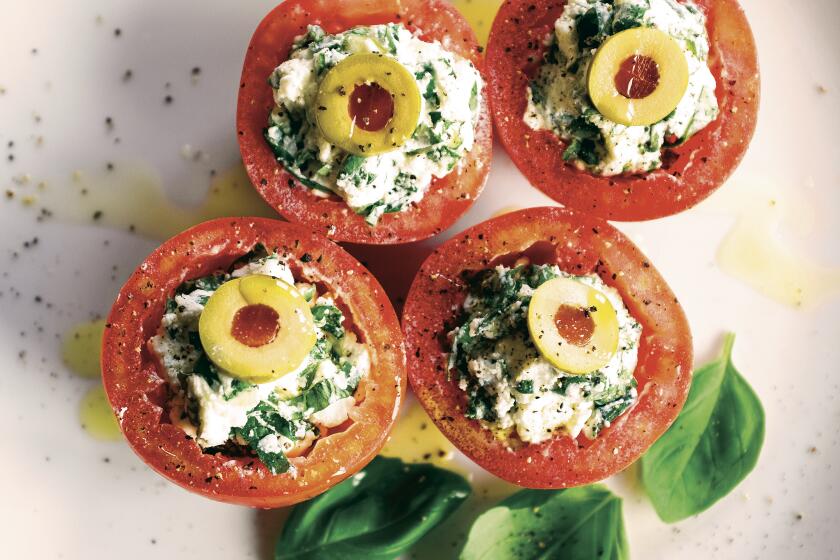Roasted fennel with Parmesan

- Share via
GIADA DE LAURENTIIS’ first book, “Everyday Italian,” based on her popular Food Network show, has been holding steady on bestseller lists since its publication last year. Just arriving in bookstores is a follow-up, “Giada’s Family Dinners” (Clarkson Potter, $32.50).
Lavishly illustrated, it offers 117 recipes for easy, accessible Italian dishes, ranging from the traditional -- pasta e fagioli and minestrone -- to the contemporary -- rack of lamb with mint-basil pesto and turkey with herbes de Provence and citrus.
There’s plenty of familiar Italian food, but it’s often reworked to De Laurentiis’ own taste, such as when she makes a quick, light Bolognese sauce with turkey or spruces up a carbonara with chicken, walnuts and lemon.
The first book concentrated on basics. This one moves on to food that’s a bit more ambitious including Italian holiday dishes, grilled meats and party-size food. Some of the recipes are straight from Italy. Born in Rome, De Laurentiis grew up in Los Angeles and lives here now. Her famous grandfather, movie producer Dino De Laurentiis, was born in Naples into a family that owned a pasta factory.
No wonder the Food Network sought her out. She’s slim, gorgeous -- and thoroughly grounded in cooking. As a youngster, De Laurentiis hung out at the DDL Food Show, a gourmet shop that her grandfather opened in Beverly Hills in 1984. There she watched chefs from Italy create pastas, pizzas and other dishes for the shop, including a baked angel hair timbale that she has revamped for the book.
Fascinated by what she had observed, De Laurentiis went on to train at Le Cordon Bleu in Paris, work at Spago and establish her own catering firm. Then TV beckoned. “Everyday Italian” debuted in 2003. In October, De Laurentiis started a second show, “Behind the Bash,” in which she examines the makings of great parties.
Her food isn’t cutting edge, but that’s not the point. “This is the kind of unpretentious, authentic, down-home Italian cooking that my family loves,” she writes in the introduction to “Giada’s Family Dinners.”
The recipes are straightforward and require no special techniques or equipment, except for pots large enough to hold big amounts of soup and pasta. I tried nine of them, plus one from her first book, and was able to buy all the ingredients (except for extra slim asparagus for a pasta dish) at neighborhood supermarkets. This practicality is one reason fans appreciate De Laurentiis’ recipes. Her style is warm and friendly, never intimidating. And she writes with such enthusiasm that you want to try every dish.
Although there’s no skimping on rich ingredients such as butter, cream, goat cheese and mascarpone, and freshness is important, De Laurentiis frequently makes use of convenience ingredients. In the soup section, every recipe calls for purchased broth, sometimes in prodigious amounts (a beef lentil soup calls for six 14-ounce cans).
And unfortunately, the book seems hastily put together, perhaps in a rush to capitalize on De Laurentiis’ popularity. It’s frustrating to find errors that recipe testers and proofreaders should have caught, especially when you’re in the middle of preparing a dish.
An apricot crostata recipe, for example, lists the juice and grated zest of a lemon as ingredients, but the directions never explain how the juice is to be used. The crostata is wonderful with or without the juice, however. Even a novice could handle the pastry base.
Chocolate chip cookies did not “flatten slightly,” as the recipe indicated, but ran together. The dough for chocolate anise biscotti was too soft and sticky to shape into a log and then transfer to a baking sheet. It has to be shaped directly on the sheet. An alert cook can compensate for such flaws, but the book’s intended audience is beginning or casual cooks. And in the case of a recipe for pepperoncini shrimp, the procedure was too poorly defined for even an experienced cook to unravel.
On the other hand, the pasta dish recipes I tried worked well. Penne with spinach sauce was absolutely beautiful, tossed with baby spinach leaves and a creamy puree of goat cheese, spinach and garlic that turns the penne a light green. (In the Test Kitchen, we tweaked the recipe a bit, substituting regular penne for the whole wheat the recipe called for, which had a gummy texture, and replacing reduced-fat cream cheese with additional goat cheese.) Farfalle combined with cremini mushrooms, short lengths of very fine asparagus, mascarpone and toasted walnuts is sumptuous and easy to prepare.
A side dish of roasted fennel with Parmesan cheese is a terrific, simple idea that works well.
Despite the glitches, I wouldn’t hesitate to recommend this book. The recipes are varied enough to please everyone, from kids who will clamor for Italian style s’mores to busy cooks who will find a quick marinara sauce a godsend. The procedures are easy, the flavors are satisfying and the food is attractive. It is, however, important to study the recipes in advance to detect anything that is not clear before starting. “When you’re in a rush to get dinner on the table, take some shortcuts,” De Laurentiis writes. But a missing step isn’t the sort of shortcut she intended.
Heat the oven to 375 degrees. Lightly oil a 13-by-9-inch baking dish. Arrange the fennel in the dish. Sprinkle with salt and pepper, then with the Parmesan cheese. Drizzle with the oil.
Bake until the fennel is fork-tender and golden brown, about 50 minutes.
Chop enough fennel fronds to equal 2 teaspoons, then sprinkle over the roasted fennel and serve.
Get our Cooking newsletter
Get a taste of Los Angeles — and the world — with recipes and kitchen tricks from the L.A. Times’ Cooking newsletter.
You may occasionally receive promotional content from the Los Angeles Times.















